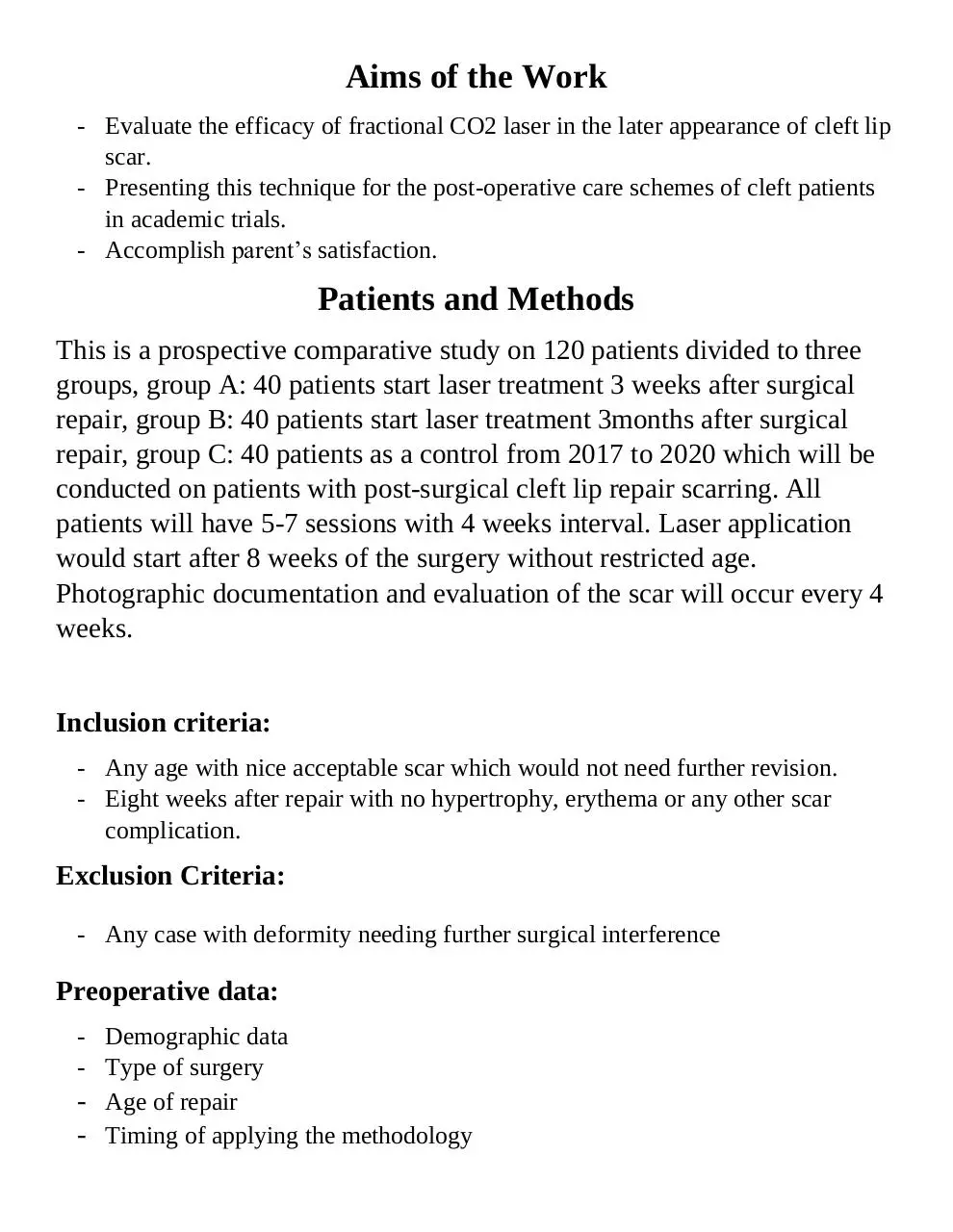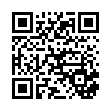protocol (PDF)
File information
This PDF 1.7 document has been generated by Microsoft® Word 2016, and has been sent on pdf-archive.com on 06/09/2017 at 20:06, from IP address 195.246.x.x.
The current document download page has been viewed 426 times.
File size: 859.36 KB (8 pages).
Privacy: public file





File preview
Plastic Surgery Dept.
Faculty of Medicine
Assuit University
Assessment of fractional CO2 laser in treatment of Postsurgical scarring of Cleft Lip
Thesis protocol
Mohamed Shadad Rateb Mohamed
Resident of Plastic Surgery
Assuit University Hospitals
Under Supervision of
Prof. Mohamed Elshazly
Professor of Plastic Surgery
Faculty of Medicine
Assiut University
Dr. Wagdy Mohamed Ali
Lecturer of Plastic Surgery
Faculty of Medicine
Assiut University
2017
قسم جراحة التجميل و الحروق
كلية الطب
جامعة أسيوط
تقييم الليزر ثنائي اكسيد الكربون الجزيئي في معالجة ندبة ما بعد
عملية إصالح الشفة األرنبية
بروتوكول مقدم من
محمد شداد راتب محمد
طبيب مقيم بقسم جراحة التجميل و الحروق
مستشفى أسيوط الجامعي
توطئة
للحصول على درجة الماجستير في جراحة التجميل و الحروق
تحت إشراف
أ.د محمد الشاذلي
أستاذ جراحة التجميل
كلية الطب جامعة اسيوط
د وجدي محمد علي
مدرس جراحة التجميل
كلية الطب جامعة أسيوط
2017
Introduction
The carbon dioxide laser (CO2 Laser) was one of the earliest gas lasers to be
developed. It was invented by Kumar Patel of Bell Labs in 1964. CO2 laser is the
highest power continuous wave lasers that are currently available which produces a
beam of infrared light with the principal wavelength bands centering on 9.4 and 10.6
micrometers. Patel, C. K. N. (1964).
When CO2 beam of light is selectively applied to the skin, it heats and vaporizes
various layers of skin, instantly treating damaged skin and wrinkles while smoothing
out the surface of the skin. The skin remodeling occurs with new skin and collagen
growth. The healing typically involves an open surface which takes weeks to heal
and typically results in loss of the baseline pigmentation leading to variable lightening
of skin. Dover, J. S. (2012)
Fractional CO2 laser resurfacing is a revolutionary delivery system that provides
dramatic skin improvement without surgery. Matrix combines the benefits of CO2
laser by using microlaser columns "points of light" to treat the epidermis and dermal
layers of your skin. Bernstein et al (1997)
Cleft lip is a form of lip malformation that occurs very early in pregnancy, the
incidence of cleft lip in the population is approximately 0.5-2 in 1000 live births.
Male children are affected more often than female children. Michalski AM et al
(2015).
Cleft lips are usually picked up during the mid-pregnancy anomaly scan carried
out when you're between 18 and 21 weeks pregnant. Not all cleft lips will be obvious
on this scan and it's very difficult to detect a cleft palate on a routine ultrasound scan.
Mossey et al (2009).
Because each cleft is unique, definitive repair of the cleft lip should be
individualized as Mirault, Le Mesurier, Tennison and Millard. Stal S et al, (2009)
Aims of the Work
- Evaluate the efficacy of fractional CO2 laser in the later appearance of cleft lip
scar.
- Presenting this technique for the post-operative care schemes of cleft patients
in academic trials.
- Accomplish parent’s satisfaction.
Patients and Methods
This is a prospective comparative study on 120 patients divided to three
groups, group A: 40 patients start laser treatment 3 weeks after surgical
repair, group B: 40 patients start laser treatment 3months after surgical
repair, group C: 40 patients as a control from 2017 to 2020 which will be
conducted on patients with post-surgical cleft lip repair scarring. All
patients will have 5-7 sessions with 4 weeks interval. Laser application
would start after 8 weeks of the surgery without restricted age.
Photographic documentation and evaluation of the scar will occur every 4
weeks.
Inclusion criteria:
- Any age with nice acceptable scar which would not need further revision.
- Eight weeks after repair with no hypertrophy, erythema or any other scar
complication.
Exclusion Criteria:
- Any case with deformity needing further surgical interference
Preoperative data:
- Demographic data
- Type of surgery
- Age of repair
- Timing of applying the methodology
Procedure data:
- Parameters
- Intervals (every 4 weeks)
- No. of sessions (5-7)
Post-procedure Care:
-
Type of used cream both in research and control groups
Photography
Methodology application
Instructions
Photographic Documentation:
- Position ( Ant. Post – Ant. Lateral – Dead Lateral)
- Before every session
Methodology Applications for evaluation of the scar:
- Vancouver scar scale
- Visual Analogue Scale
- Scar Width Assessment
Evaluation of the scar:
- Vancouver Scar Scale (VSS)
The VSS, first described by Sullivan in 1990, is perhaps the most recognized
burn scar assessment method. Nedelec B et al, (2000). It assesses 4 variables:
vascularity, height/thickness, pliability, and pigmentation. Patient
perception of his or her respective scars is not factored in to the overall score.
Vancouver scar scale
Scar Characteristic
Vascularity
Pigmentation
Pliability
Height
Normal
Pink
Red
Purple
Normal
Hypopigmentation
Hyperpigmentation
Normal
Supple
Yielding
Firm
Ropes
Contracture
Flat
<2mm
2-5mm
>5mm
Total score
Score
0
1
2
3
0
1
2
0
1
2
3
4
5
0
1
2
3
13
Visual Analogue Scale
This depends on 5 independent medical and nonmedical personel rating results on
graded scale 0-10
Scar Width Assessment
This depends on studying the final images with Photoshop CS5 Extended Version
in two fixed points of the scar width.
References
- Martin, J. A., Kung, H. C., Mathews, T. J., Hoyert, D. L., Strobino, D. M.,
Guyer, B., & Sutton, S. R. (2008). Annual summary of vital statistics: 2006.
Pediatrics, 121(4), 788-801.
- Watkins, S. E., Meyer, R. E., Strauss, R. P., & Aylsworth, A. S. (2014).
Classification, epidemiology, and genetics of orofacial clefts. Clinics in plastic
surgery, 41(2), 149-163.
- Kaplan, I. (2007). The CO2 laser as a versatile surgical modality. Laser
Therapy, 16(1), 25-38.
- Dover, J. S. (2012). Fractional laser skin resurfacing. J Drugs Dermatol,
11(11), 1274-1287.
- Ross, E. V., Barnette, D. J., Glatter, R. D., & Grevelink, J. M. (1999).
Effects of overlap and pass number in CO2 laser skin resurfacing: a study of
residual thermal damage, cell death, and wound healing. Lasers in surgery and
medicine, 24(2), 103-112.
- Bernstein, L. J., Kauvar, A. N., Grossman, M. C., & Geronemus, R. G.
(1997). The short‐and long‐term side effects of carbon dioxide laser
resurfacing. Dermatologic Surgery, 23(7), 519-525.
- Elliot, D. A. V. I. D., Cory-Pearce, R. I. C. H. A. R. D., & Rees, G. M.
(1985). The behaviour of presternal scars in a fair-skinned population. Annals
of the Royal College of Surgeons of England, 67(4), 238
- Arosarena, O. A. (2007). Cleft lip and palate. Otolaryngologic Clinics of
North America, 40(1), 27-60
- Patel, C. K. N. (1964). Continuous-Wave Laser Action on VibrationalRotational Transitions of C O 2. Physical review, 136(5A), A1187.
- Abbott, M. M., & Meara, J. G. (2011). A microcosting approach for isolated,
unilateral cleft lip care in the first year of life. Plastic and reconstructive
surgery, 127(1), 333-339
- Mossey, P. A., Little, J., Munger, R. G., Dixon, M. J., & Shaw, W. C.
(2009). Cleft lip and palate. The Lancet, 374(9703), 1773-1785.
- Bitik, O., & Uzun, H. (2013). Reconstruction of central upper lip defects with
the subcutaneous pedicled nasolabial island flap: a single-stage alternative to
Abbe flap in the elderly male. Journal of Craniofacial Surgery, 24(4), e337e338.
- Stal S, Brown RH, Higuera S, Hollier LH Jr, Byrd HS, Cutting CB, et al.
Fifty years of the Millard rotation-advancement: looking back and moving
forward. Plast Reconstr Surg. 2009 Apr. 123(4):1364-77.
- Michalski AM, Richardson SD, Browne ML, et al. Sex ratios among infants
with birth defects, National Birth Defects Prevention Study, 1997-2009. Am J
Med Genet A. 2015 Feb 25.
- Nedelec B, Shankowsky A, Tredgett EE. Rating the resolving hypertrophic
scar: comparison of the Vancouver Scar Scale and scar volume. J Burn Care
Rehabil. 2000;21:205–12
Download protocol
protocol.pdf (PDF, 859.36 KB)
Download PDF
Share this file on social networks
Link to this page
Permanent link
Use the permanent link to the download page to share your document on Facebook, Twitter, LinkedIn, or directly with a contact by e-Mail, Messenger, Whatsapp, Line..
Short link
Use the short link to share your document on Twitter or by text message (SMS)
HTML Code
Copy the following HTML code to share your document on a Website or Blog
QR Code to this page

This file has been shared publicly by a user of PDF Archive.
Document ID: 0000669270.